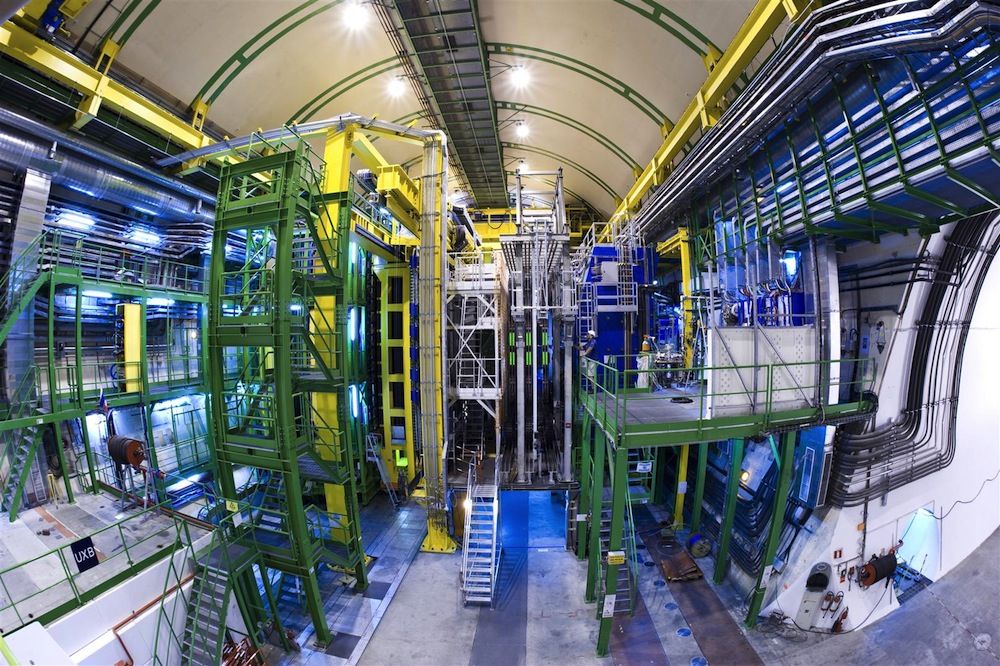
Editor's Note: This story was updated on Friday Sept. 11 at 2:45 p.m. E.T.
Trouble is brewing in the orderly world of subatomic physics.
New evidence from the world's largest atom smasher, the Large Hadron Collider in Geneva, Switzerland, suggests that certain tiny subatomic particles called leptons don't behave as expected.
So far, the data only hint at these misbehaving leptons. But if more data confirm their wayward behavior, the particles would represent the first cracks in the reigning physics model for subatomic particles, researchers say. [See Photos of the World's Largest Atom Smasher]
Reigning model
A single model, called the Standard Model, governs the bizarre world of the teensy tiny. It dictates the behavior of every subatomic particle, from ghostly neutrinos to the long-sought Higgs boson (discovered in 2012), which explains how other particles get their mass. In hundreds of experiments over four decades, physicists have confirmed over and over again that the Standard Model is an accurate predictor of reality.
But the Standard Model isn't the whole picture of how the universe operates. For one, physicists haven't found a way to reconcile the microcosm of the Standard Model with Einstein's theory of general relativity, which describes how mass warps space-time on a larger scale. And neither theory explains the mysterious substance called dark matter, which makes up most of the universe's matter, yet emits no light. So physicists have been on the hunt for any results that contradict the Standard Model's basic premises, in the hopes that it could reveal new physics. [Beyond Higgs: 5 Other Particles That May Lurk in the Universe]
Sign up for the Live Science daily newsletter now
Get the world’s most fascinating discoveries delivered straight to your inbox.
Cracks in the foundation
Physicists may have found one such contradiction at the Large Hadron Collider (LHC), which accelerates beams packed with protons around a 17-mile-long (27 kilometers) underground ring and smashes them into one another, creating a shower of short-lived particles.
While sifting through the alphabet soup of short-lived particles, scientists with the LHC's beauty experiment (LHCb) noticed a discrepancy in how often B mesons — particles with mass five times that of the proton — decayed into two other types of electronlike particles, called the tau lepton and the muon.
The LHCb scientists noticed slightly more tau leptons than they expected, which they first reported earlier this year. But that result was very preliminary. From LHCb data alone, there was a high chance — about 1 in 20 — that a statistical fluke could explain the findings.
"This is a small hint, and you would have not been supremely excited until you see more of it," said Hassan Jawahery, a particle physicist at the University of Maryland in College Park, who works on the LHCb experiment.
But this same discrepancy in the tau-lepton-muon ratio has cropped up before, at Stanford University's BaBar experiment, which tracked the fallout from electrons colliding with their antimatter partners, positrons.
With both data sources combined, the odds that the tau-lepton-muon discrepancy is a byproduct of random chance drops significantly. The new results are at a certainty level of "4-sigma," which means there is a 99.993 percent chance the discrepancy between tau leptons and muons represents a real physical phenomenon, and is not a byproduct of random chance, the researchers reported Sept. 4 in the journal Physical Review Letters. (Typically, physicists announce big discoveries, such as that of the Higgs boson, when data reaches a 5-sigma level of significance, meaning there's a 1 in 3.5 million chance that the finding is a statistical fluke.)
"Their values are totally in line with ours," said Vera Luth, a physicist at Stanford University in California who worked on the BaBar experiment. "We're obviously thrilled that it doesn't look totally like a fluctuation. It may actually be right."
Strange new worlds?
Of course, it's still too early to say with absolute certainty that something fishy is going on in the world of the very small. But the fact that similar results have been found using completely different experimental models bolsters the LHCb findings, said Zoltan Ligeti, a theoretical physicist at Lawrence Berkeley National Laboratory in California, who was not involved in the current experiments. In addition, the B-factory at the atom-smashing KEK-B experiment in Japan has found a similar deviation, he added.
If the phenomenon they've measured holds up with further testing, "the implications for theory and how we view the world would be extremely substantial," Ligeti told Live Science. "It's really a deviation from the Standard Model in a direction that most people would not have expected."
For instance, one of the top contenders to explain dark matter and dark energy is a class of theories known as supersymmetry, which posits that each known particle has a superpartner with slightly different characteristics. But the most popular versions of these theories cannot explain the new results, he said.
Still, the new results aren't confirmed yet. That will have to wait until the team begins analyzing data from the newest run of the LHC, which ramped up to nearly double the energy levels in April, Jawahery said.
"The uncertainties are still large, and we would like to do better," Luth said. "I'm sure the LHCb will do that."
Editor's Note: This story was updated to correct the description of the B-meson. It has a mass roughly five times the mass of a proton, and is not a force-carrier.
Follow Tia Ghose on Twitterand Google+. Follow Live Science @livescience, Facebook & Google+. Original article on Live Science.

Tia is the managing editor and was previously a senior writer for Live Science. Her work has appeared in Scientific American, Wired.com and other outlets. She holds a master's degree in bioengineering from the University of Washington, a graduate certificate in science writing from UC Santa Cruz and a bachelor's degree in mechanical engineering from the University of Texas at Austin. Tia was part of a team at the Milwaukee Journal Sentinel that published the Empty Cradles series on preterm births, which won multiple awards, including the 2012 Casey Medal for Meritorious Journalism.











